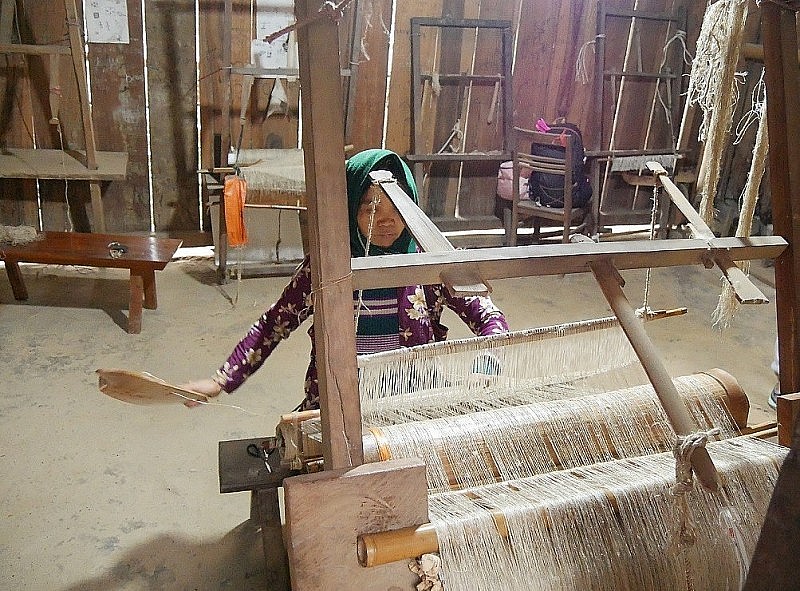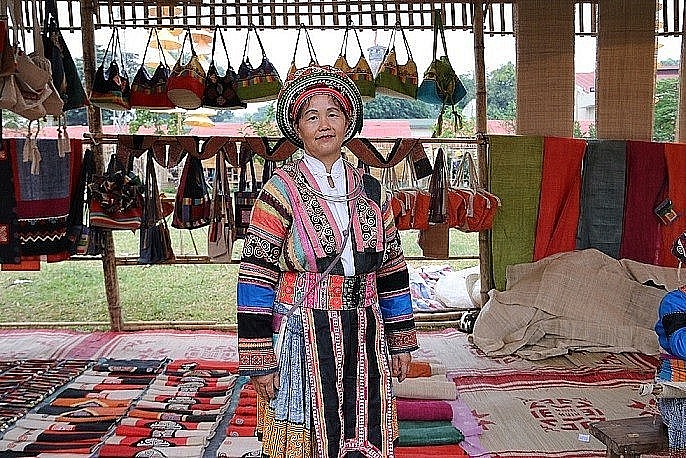
Lung Tam linen weaving craft village: Shuttlecocks bustiling, clicking their revitalizing sound
Latest
 |
| Many households in Lung Tam started to earn substantial income from traditional linen weaving. (Photo: Thanh Tam) |
For the last two years (2020, 2021), the COVID-19 pandemic has caused Lung Tam linen weaving craft village to face many difficulties due to no tourists or visitors. This also caused the stricken workforce in Hop Tien Linen Weaving Cooperative.
Out of 23 previously registered skilled workers, who would work regularly at the Cooperative, only 6 artisans could be retained for on-site work, and the others received raw materials for production at home.
According to Ms. Vang Thi Mai, Director of Hop Tien Linen Weaving Cooperative: Linen weaving is an heirloom of many H’mong families in Lung Tam. In the past, cloth was made only to serve the needs of the family. Because the process of making products was completely done manually, the productivity is not high. Moreover, due to the lack of sensitivity to the market, Lung Tam's linen products are little known to outside consumers.
Realizing the potential value of the craft village, in 1998, Ms. Mai and her husband, Mr. Sung Mi Qua, started up and mobilized the people in the commune to contribute capital to set up the Hop Tien Linen Weaving Facility.
In August 2001, Lung Tam linen cooperative was officially established bearing the name “Hop Tien Linen Weaving Cooperative”, with the "shares" contributed in kind by the people including the previously produced tradable items of skirts, blouses, towels, blankets, pillows, carpets, brocade wallets, men's shirts, bags, and backpacking gear.
Since its establishment and operation, Hop Tien Cooperative has attracted many women in the commune to participate. Previously, women would do the weaving at home. Now they gather for sewing, embroidery and weaving at the cooperative’s premises. This is also the facility where the products are advertised and sold to tourists and visitors.
Up to now, the cooperative has produced over 20 different types of products and found regular customers, such as CRAFT LINK organization (under the Vietnam Handicraft Research Center). CRAFT LINK also supports the cooperative to introduce and promote the products to international tourist groups who love brocade.
Ms. Vang Thi Mai added: “Immediately after the cooperative establishment, many participating households began to earn substantial income from their job of traditional linen weaving. But the flourishing only really started in 2008, when she was invited by the French Embassy in Vietnam to attend the Global Creative and Dynamic Women's Tradefair.
Through her entrepreneur story and artifacts of delicate patterns and vignettes, her counterparts in many countries around the world are very interested in Lung Tam linen materials.
“Good wine needs no bush”, many domestic and foreign tourists coming to Ha Giang rocky plateau have to come to Lung Tam to learn directly about the linen weaving techniques of the H’Mong people, as well as to buy beautiful gifts which are made from the skillful hands of mountainous people born on white rocky land.
When the linen weaving is restored, in addition to developing production and raising livestock at home, the women in Lung Tam linen cooperative have an additional income of VND 1.2-1.8 million ( approximately USD85) per month. Following the properly oriented business, in recent years, the life of linen workers has been gradually improved, most households have escaped poverty; and it is more significant when the traditional handicraft is consciously preserved by the local people.
After 41 manual processing stages, meticulously and patiently, the Lung Tam brocade linen fabric takes its shape. Each textile product in Lung Tam has its own distinguishing traditional patterns. Each image has its own meaning and is mainly a Hmong motif and vignette.
 |
| Artist Vang Thi Mai of Lung Tam village in a showbooth at Hanoi Long Dress Festival in 2016. (Photo: Thanh Thuan) |
It is that uniqueness that has helped Lanh Lung Tam weaving village to have a place in the handicraft market and build great economic values for the people.
Raw linen, after being woven, appears as patterns of daily life or simply simple motifs that are delicately and elaborately integrated.
However, in 2020 and 2021, due to the impact of the COVID-19 pandemic, linen weaving in Lung Tam confronted really difficult challenges. Among 23 skilled workers, who would work regularly at Hop Tien Linen Weaving Cooperative, only 6 artisans could be retained for on-site work, and the others received raw materials for production at home.
Now that the pandemic is under control, young men and women from all over the country have joyfully returned to Ha Giang rocky plateau, and Lung Tam is one of their preferred destinations.
Not only are they good at weaving, the H’Mong people in Lung Tam also have indigo dyeing techniques that are hard to match by anyone, anywhere else. This is an advantage for local authorities and agencies and mass organizations to continue to make investment, creating all favorable conditions to help Lung Tam linen become a cultural souvenir of the H’Mong people, standing firm, and for market expansion.
Lung Tam is nestled among the foggy mountain peaks all year round. Linen weaving is a traditional handicrart closely associated with the Mong people here. In recent years, the life of the Mong people in the white, cloudy land has changed remarkably thanks to traditional linen weaving.













